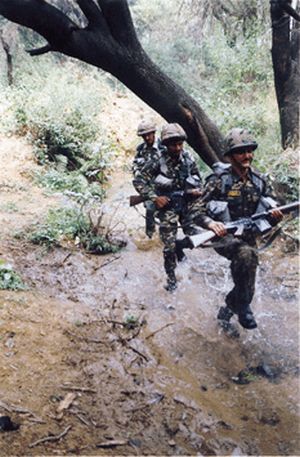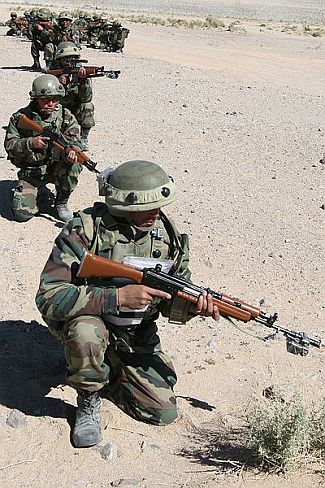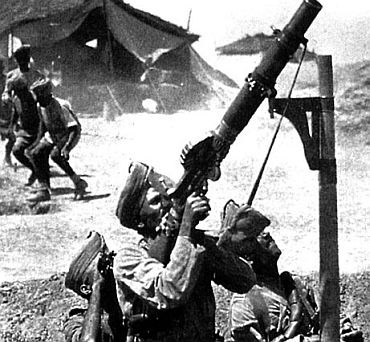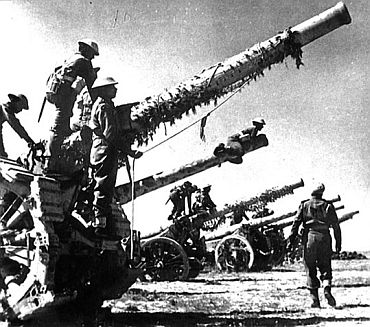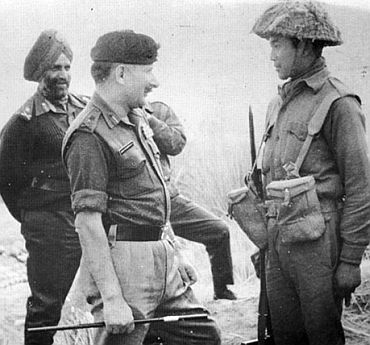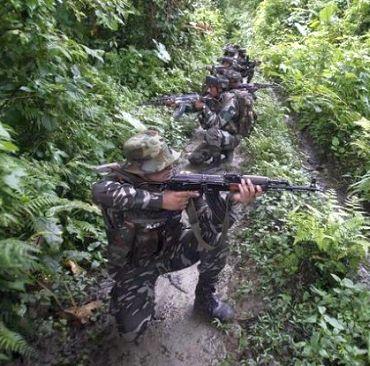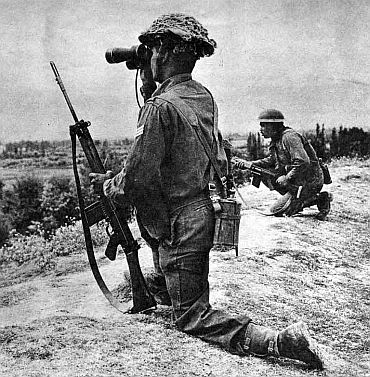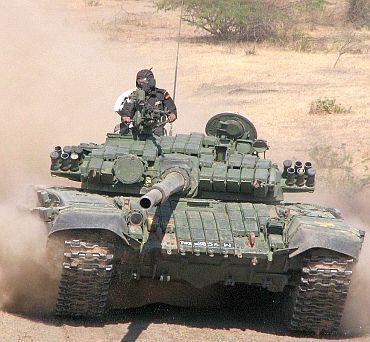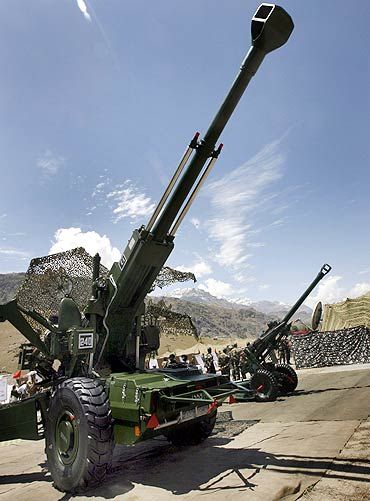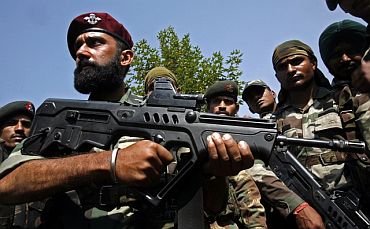 | « Back to article | Print this article |
Indian Army: Standing the test of times
Nitin Gokhale pays tribute to one of the finest armies of the world ahead of the 62nd Army Day on January 15, 2011
For a change, instead of writing on India's neighbours as I usually do in my column, I want to pay a tribute to one of India's finest and perhaps the last surviving credible institutions -- the Indian Army.
I know that given the recent shame of Aadarsh and Sukna, dal generals and booze brigadiers, I know I am sticking my neck out, but here goes my take on the Indian Army just ahead of Army Day 2011 on January 15th!
Flashback, 1998
Assam's Nalbari district, like the rest of the state, was under waist-deep water. The raging rivers rushing down from the mountains of Bhutan had engulfed lower Assam in a devastating wave of floods. People were hanging onto the rooftops and sitting on trees. In many places, it was impossible to see land.
After two days of struggle with nature's fury, the state administration was forced to call in the army for rescue and relief.
Click on NEXT to read further...
Engaging the nation without hesitation
Within hours, the local army units, otherwise engaged in a counter-insurgency role under Operation Rhino, had fanned out to the interiors with their boats and medical teams; Indian Air Force and Army helicopters were pressed into service to drop food and rescue people stuck in hopeless positions.
Over the next fortnight, the army along with the state administration, had not only saved many lives but had ensured that small diseases did not turn into an epidemic.
Even for someone like me who had seen this happen with unfailing regularity year after year in Assam, the job done by the soldiers and officers that monsoon season seemed like a Herculean task by any standards.
And remember, the army was -- as it still is -- primarily engaged in a CI role in Assam; the people were by and large wary of the troops, if not downright hostile; the insurgents were still strong in pockets like the hardcore support areas of Nalbari and Tamulpur.
And yet, the army went in without hesitation, undertook flood relief and quickly readjusted itself. This is not an isolated incident.
The army is India's Brahmaastra
From Tangdhar to Machhilipattnam and from Bhuj to Tawang, the army has come to the aid of the people across India during times of crisis.
Hundreds of such stories abound in the Indian Army's journey in both war and peace since independence.
From disaster relief in floods, tsunami, and earthquakes to rescuing infant Prince from a deep tube well and from quelling rioters in communal strife to being the last resort in internal counter-insurgency operations, the Indian Army is omnipresent.
It is, what I call, India's Brahmaastra (an ultimate weapon).
The versatility, adaptability, selfless attitude and resourcefulness of the Indian Army has allowed it to be what it is today: Nation Builders.
And viewed in the context of India's immediate and extended neighbourhood, the Indian Army's stellar role stands out in stark contrast to its counterparts in other countries.
Remember, Indian and Pakistani Armies originated from the same source, the British Army and yet, six decades since they parted ways, there couldn't be a bigger dissimilarity in the way the two have evolved.
Army has scrupulously remained apolitical
Despite India's increasing dependence on the army to pull its chestnuts out of fire time and again, the army has scrupulously remained apolitical.
The contribution of the army in nurturing and strengthening democracy -- with all its faults -- can never be underestimated.
It has put down fissiparous and secessionist forces within India with great cost to itself over these 60 years. It has protected India from within and without.
The army also has a unique distinction of helping create a nation (Bangladesh) in the neighbourhood and then quietly walking away to let the people take charge.
Service before Self: That's why the Indian Army is so distinct
By contrast, the Pakistan Army has never really allowed democracy to flourish in its country. Instead, it has created a military-industrial complex that has spread its tentacles in every aspect of governance.
Even today, the Pakistan Army does not let go of any opportunity to undercut democracy; it nurtures and treats jihadi elements as its strategic asset against India and the United States.
Even in other smaller nations around India -- Nepal, Myanmar and Bangladesh, for instance -- the armed forces have had to intervene and run the affairs of those countries at some point.
So who or what makes the Indian Army so distinct?
Simply put its leaders and its men and their ethos of "Service before self."
From the early days of Independence, Indian military leaders -- stalwarts like KM Cariappa, Rajendra Singhji, KS Thimayya and later Sam Manekshaw -- led the forces from the front and provided a strong moral centre that has remained more or less in tact, some very regrettable instances of moral and monetary corruption notwithstanding.
For every crisis that the country has faced, military and non-military, the Indian Army has risen splendidly to the occasion.
Army's origins were far from flattering
A Long, Eventful Journey
The army has grown from a force of sepoys that served the East India Company in its early days to a thoroughly professional and apolitical force respected the world over.
But the makeover has come with tremendous hard work, sweat, blood and sacrifice. The origins were far from flattering though.
Nearly four centuries ago, the British East India Company after its arrival in India, used Indian sepoys like a private militia, deployed primarily to protect its establishments and personnel.
Later, the forces were reconstituted as the Presidency Armies of Bombay, Madras and Calcutta. In 1748, they were amalgamated under Major Stringer Lawrence who became the commander-in-chief of all the company's forces in India.
That arrangement continued for over a century until 1857 when the sepoys became conscious for the first time that they belonged to one country.
Although the British succeeded in putting down the rebellion, they had to effect many fundamental changes in the structure of the force.
As a first step, the army was brought under the British Crown. A Viceroy started administering India. British officers were given the Queen's Commission, and the Indians the Viceroy's Commission, later known as Junior Commissioned Officers.
British Indian Army stood out in the 2 World Wars
In the late 19th and early 20th century, the British Indian Army participated in various campaigns in Africa, the Middle East, Tibet and other parts of the world and distinguished itself through its fighting qualities.
The early signs of these qualities were evident in the First World War.
According to official figures, 36,596 Indian soldiers died fighting in Europe, North Africa, and the Middle East, during the First World War. Over 70,000 were wounded. Indians won 16 Victoria Crosses and 90 Military Crosses.
After a stellar performance in World War I, it was inevitable that the demand to induct Indians as Commissioned Officers would begin to gain currency.
Several prominent Indian political leaders like Sir Tej Bahadur Sapru, Madan Mohan Malaviya and Motilal Nehru pressured the British on this count.
Grudgingly, they agreed to Indianise selected units of the Indian Army and also induct Indians in the officer ranks.
First batch of Indian officers arrived in 1934
To start with 20 seats were reserved for Indians at the Military College in Sandhurst, Britain. Those who passed out became King's Commissioned Indian Officers.
Under pressure to Indianise the officer cadre, the British agreed to establish the Indian Military Academy in Dehradun in 1932.
Two years later, in 1934 the first batch of Indians was commissioned, among them was India's best known military figure -- Sam 'Bahadur" Manekshaw!
When the Second World War broke out in 1939, national leaders were not in favour of Indians participating, but the British went ahead. Army units were inducted in all theatres of war.
According to globalsecurity.org, a leading web-based portal on military affairs and history, between 1939 and mid-1945, the British Indian Army expanded from about 175,000 to more than 2 million troops -- entirely through voluntary enlistment.
The code of secular ethos
More than 620,000 Indians served overseas during World War II (1939-1945).
Indians fought in North Africa and Italy. After Japanese forces defeated United Kingdom troops in Burma, the Indian Army had to defend its own country at the battles of Imphal and Kohima in 1944.
The Japanese besieged Kohima but never captured it. About 340,000 Indians served in the Allies' 14th army, which eventually drove the Japanese out of Burma.
These campaigns also sowed the seeds of, what I call a 'distinguishing' army code of conduct: The code of secular ethos.
The ethos of true secularism under which soldiers from different castes, religions and regions, regard themselves as Indians first and Sikhs, Marathas, Jats, Dogras or whatever later, were entrenched in the Indian Army very early.
It is not surprising therefore to see that since Independence, one institution that has remained absolutely free of communalism is the Indian Army. When caste and religious differences have beset the country's politics and society at large, the Indian army has stood firm against these divisive forces.
So when freedom came in 1947, India inherited an experienced army toughened in the crucible of WW-II.
Army has always come out with flying colours
That experience came in handy in the immediate aftermath of India's Independence. As the country underwent a painful and bloody partition, it fell upon the secular, compassionate and disciplined army to keep order in those months of communal madness that engulfed the Indian sub-continent in 1947-48.
And even as the communal conflagration kept the army fully occupied, Pakistan mounted a determined effort to wrest Kashmir from India's control. Those two years tested the army fully but it is to the credit of the army's leadership and men that they withstood that attack and saved Kashmir.
Subsequently India has had to face four more external attacks and except the 1962 debacle, each time the army has come out with flying colours.
It must be noted here that for the setback in the Sino-Indian border war of 1962 reasons for failure have to be sought elsewhere.
It is to the army's credit that it has carried out every task given to it assiduously, without even once complaining about inadequacies that abound.
Army has stood the test of time
The Indian Army has thus stood the test of time and has consistently upheld and protected the nation's Constitution with unflinching loyalty, making a major contribution in nation building in the first six decades of India's existence as an Independent, sovereign nation.
Civilian Control or Bureaucratic Command
The army has also withstood systematic assault on its status from politicians and bureaucrats who are forever looking for ways to downgrade the military's status.
While the principle of civilian supremacy over the armed forces is well entrenched and understood in India, what is incomprehensible is the constant chipping away at the military's standing.
The nation as a whole and indeed the people at large have the highest regard and affinity for the men in uniform for the yeoman service they render in every conceivable situation, but most mandarins in the Ministry of Defence and some of the politicians do not have the same opinion and are repeatedly trying to run down the military without realising the immense damage they cause to the only available bulwark we have against any attempt to Balkanise India.
'Politicians found it convenient to keep Army out of policy-making bodies'
As former Chief of army Staff, General S Padmanabhan says in his book, A General Speaks: Even after Independence, India's political leaders found it convenient to keep the army, navy and the air force out of the 'policy' making bodies. The service HQs were left at the level that the British left them -- that of being 'attached offices,' of the Ministry of Defence. Even at the level of defence minister and service chiefs, exchanges on major matters of defence policy were few and far between
Another former Army Chief, General Shankar Roy Choudhury has observed: "It is essential in the national interest that the armed forces are upgraded and updated on an ongoing basis, something which governments have been traditionally loath to acknowledge and undertake, the Indian government perhaps more so than others in this respect.
"Historically, it is to the credit of the Indian Army that it has fulfilled its role as an organ of the state It has functioned effectively in every type of role, in spite of the general lack of a supportive government environment by way of adequate finances, resources, equipment, personnel policies, or higher political direction."
Decision-makers must consciously back the army
A nation's military provides what is called a 'hard-edged' backup to its international standing.
A strong military and especially a powerful, well-trained, fully-equipped army act as a deterrent against adversaries.
It is therefore essential that the nation's decision-makers consciously back the army and provide it with the support that it needs to meet diverse challenges that exist and are likely to come up in the coming decade.
So far, the Indian Army has fulfilled its role in nation building admirably well.
All of us, ordinary citizens, politicians, bureaucrats, must continue to back the nation's strongest asset and further strengthen it, if we desire to see India as a global player in the decades to come.
(This is an abridged version of the original piece written for an army journal)


